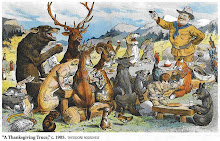White-nose syndrome that kills bats continues to spread
By Sandy Bauers, The Philadelphia Inquirer/newyorknewsday.com
This photo provided by the New York Department of Environmental Conservation shows a little brown bat suffering from white-nose syndrome, with the signature frosting of fungus on its nose, found in a New York cave.
It was a typically cold winter day when Greg Turner, a wildlife biologist with the Pennsylvania Game Commission, unlocked the gate at the historic Durham Mine in upper Bucks County, Pa., and stepped into the darkness.He expected things to be bad. And they were.
The long-shuttered iron ore mine — an important site for bats — typically had about 8,000 of the mammals hibernating every winter.
But in 2009, biologists discovered that white-nose syndrome, a disease that has killed millions of bats throughout the Northeast, had come to Durham Mine.
By 2011, about 180 bats remained. Just weeks ago, Turner found only 18.
"We have a 99 percent decline at this site," he reported glumly.
The story is much the same at about 60 other major sites in the state.
Ditto for New Jersey, where the primary site, Hibernia Mine in Morris County, has gone from 28,000 bats to about 600.Throughout the eastern United States, there are few glimmers of hope for the little brown bat, the species most affected by white-nose syndrome.
"White-nose syndrome is arguably the most devastating wildlife disease we've faced," said Michael T. Rains, director of the U.S. Forest Service's Northern Research Station, which studies disease outbreaks.
At stake is not just a fascinating, if somewhat creepy, mammal, but also the valuable job it does. Bats eat vast quantities of insects, including many agricultural pests and bugs that can spread disease to people. A single lactating female can eat her body weight in insects in a single night.
The trouble began in 2006, when scores of dead bats were found on the ground outside a cave inAlbany.By now, it has spread unabated through 22 states.In January, it was confirmed in Kentucky's Mammoth Cave National Park. In February, it was confirmed in Illinois. In March, Georgia and South Carolina joined the list.
The disease is called white-nose syndrome because infected bats have a white fungus on their muzzles and other body parts.
The race to understand what's happening — and find a cure — has drawn hundreds of researchers and land managers and nearly a dozen labs. Since 2008, the U.S. Fish and Wildlife Service alone has allocated nearly $8 million for research."We've learned an exceptional amount," said Ann Froschauer, a spokeswoman for the service.
Just not how to stop it.
In 2008, a researcher identified the responsible fungus, naming it Geomyces destructans.
It is a European fungus that was transported to North America — presumably on the equipment of cavers, although that can't be proven.
Researchers liken it to smallpox, which killed entire tribes of Native Americans when it spread from early European settlers.
Last month, a team of U.S. Forest Service scientists announced they had developed a sensitive DNA test that will detect the fungus in cave soil and on bats long before their muzzles turn white.
So now, scientists can know if the fungus is present "before you have dying bats everywhere," said Daniel Lindnera Forest Service fungus scientist who participated in the research. "Up until this point, that's what we were missing, a way to track the killer."
It gives scientists a chance for early intervention — if only they had a method that worked.
They can't fumigate caves, which contain many other fungi important in that environment.
They've tried compounds known to kill the fungus, including a spray that contains an ingredient from a drug for athlete's foot. So far, no luck.
Turner and DeeAnn Reeder, a biologist at Bucknell University who is a recognized white-nose researcher, put petri dishes of spearmint oil in Durham Mine, hoping that the vapors wafting over the bats would kill the fungus. But the bats moved.So next, they put cages around groups of bats. A raccoon broke in and ate them.
The genome for G. destructans has been sequenced, and researchers think that if they can find the one or more genes that the fungus uses to kill the bats, they can "silence" those genes.Meanwhile, researchers are learning more about how the fungus does its dirty work.
"We're starting to connect the dots about how you go from a skin infection to an animal that's dead," Reeder said. "Fungal infections don't typically kill you."
One thing they know: hibernating bats often rouse. But bats infected with the fungus are rousing too often and for too long, depleting their fat reserves. Starving, they leave the cave to find food. In winter, there is none.
Other factors may be at work, too. Bats with the fungus also develop lesions on their wings.
One ray of hope is that some bats, including big brown bats, aren't susceptible. Researchers are hoping to find out why.More tantalizing still: Although most little brown bats get the syndrome and die, there are survivors.
Mick Valent, a zoologist with the New Jersey Department of Environmental Protection, has begun banding bats so researchers can see if they return in subsequent years. So far, "we're seeing bats that we know have been around three years."The question now is: Are these just lucky bats that haven't been exposed yet? Or do they have an immunity that can be passed to their offspring?This summer, Reeder's students will be collecting blood samples from survivors to try to find out.
Meanwhile, conservation efforts — restricting access to caves in winter and protecting summer locales — are crucial."Every bat left in the landscape," Reeder said, "is precious."











No comments:
Post a Comment